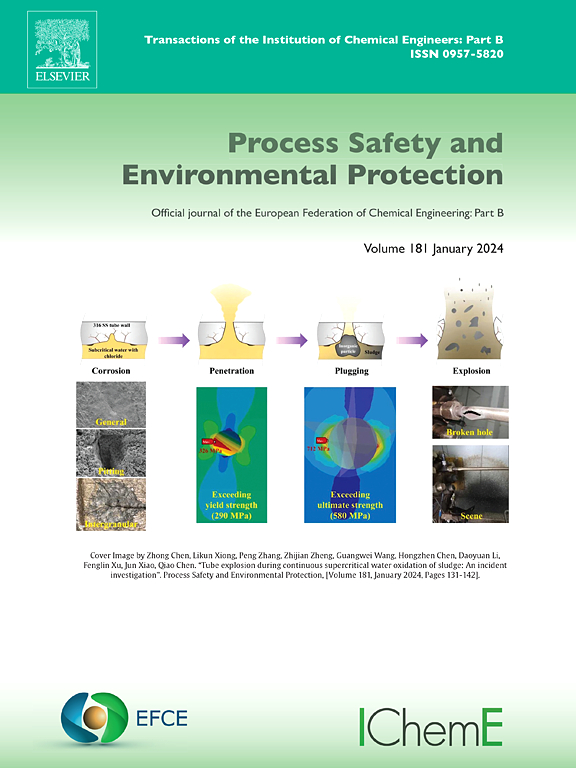Phycoremediation of ten sulfonamide antibiotics in swine wastewater: Microalgal tolerance, toxicity, and carbohydrate-rich biomass production
IF 6.9
2区 环境科学与生态学
Q1 ENGINEERING, CHEMICAL
引用次数: 0
Abstract
This study investigates the removal of ten sulfonamide antibiotic residues from swine wastewater using Chlorella spp. in a phycoremediation process. The effects of sulfonamides on microalgal biomass production, pigment content (chlorophyll α, chlorophyll b, and carotenoids), and the genotoxicity of treated water were evaluated. Sulfonamides were tested at concentrations of 0.1, 1.0, 10, 50, and/or 100 mg L⁻¹ , with the antibiotic removal specifically assessed at 10 mg L⁻¹ . Results showed that Chlorella spp. exhibited robust biomass growth and maintained stable pigment production, even at the highest concentrations, indicating the microalgae's tolerance to antibiotic exposure. The removal efficiency for sulfonamides was notably high, particularly for sulfamethoxazole (70 %), sulfachlorpyridazine (55 %), and sulfamerazine and sulfamethizole (50 %) at the 10 mg L⁻¹ concentration. Genotoxicity assays with Allium cepa revealed minimal chromosomal aberrations, suggesting that the treated wastewater posed a low genotoxic risk. The microalgal biomass, characterized by high carbohydrate content, also holds promise for biofuel production. These findings highlight Chlorella spp. as an effective and sustainable solution for mitigating antibiotic pollution in agricultural wastewater, while simultaneously providing valuable biomass for renewable energy applications.
猪废水中十种磺胺类抗生素的藻修复:微藻耐受性、毒性和富含碳水化合物的生物质生产
本研究研究了小球藻藻修复法去除猪废水中10种磺胺类抗生素残留。研究了磺胺类化合物对微藻生物量、色素含量(叶绿素α、叶绿素b和类胡萝卜素)以及处理后水体遗传毒性的影响。磺胺类药物的浓度分别为0.1、1.0、10、50和/或100 mg L⁻¹ ,抗生素的去除效果特别为10 mg L⁻¹ 。结果表明,即使在最高浓度下,小球藻也表现出强劲的生物量增长和稳定的色素生产,表明微藻对抗生素的耐受性。对磺胺类药物的去除率特别高,特别是对10 mg L⁻¹ 浓度下的磺胺甲氧唑(70 %)、磺胺氯吡啶(55 %)和磺胺嘧啶和磺胺甲唑(50 %)的去除率最高。用葱属植物进行的遗传毒性试验显示染色体畸变最小,表明处理后的废水具有低遗传毒性风险。微藻生物量的特点是碳水化合物含量高,也有望用于生物燃料生产。这些发现表明,小球藻是缓解农业废水中抗生素污染的有效和可持续的解决方案,同时为可再生能源的应用提供了宝贵的生物质。
本文章由计算机程序翻译,如有差异,请以英文原文为准。
求助全文
约1分钟内获得全文
求助全文
来源期刊

Process Safety and Environmental Protection
环境科学-工程:化工
CiteScore
11.40
自引率
15.40%
发文量
929
审稿时长
8.0 months
期刊介绍:
The Process Safety and Environmental Protection (PSEP) journal is a leading international publication that focuses on the publication of high-quality, original research papers in the field of engineering, specifically those related to the safety of industrial processes and environmental protection. The journal encourages submissions that present new developments in safety and environmental aspects, particularly those that show how research findings can be applied in process engineering design and practice.
PSEP is particularly interested in research that brings fresh perspectives to established engineering principles, identifies unsolved problems, or suggests directions for future research. The journal also values contributions that push the boundaries of traditional engineering and welcomes multidisciplinary papers.
PSEP's articles are abstracted and indexed by a range of databases and services, which helps to ensure that the journal's research is accessible and recognized in the academic and professional communities. These databases include ANTE, Chemical Abstracts, Chemical Hazards in Industry, Current Contents, Elsevier Engineering Information database, Pascal Francis, Web of Science, Scopus, Engineering Information Database EnCompass LIT (Elsevier), and INSPEC. This wide coverage facilitates the dissemination of the journal's content to a global audience interested in process safety and environmental engineering.
 求助内容:
求助内容: 应助结果提醒方式:
应助结果提醒方式:


